《通信原理实验》课程电子教案(PPT讲稿)MATLAB与通信仿真(英文)Chapter 2 Analog Modulation(Conventional AM)
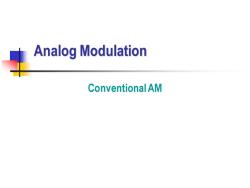
Analog Modulation Conventional AM
Analog Modulation Conventional AM

Conventional AM Quite similar to DSB-AM Easy to demodulate by employing envelope detector m(t) Normalize 1+am,(t) u(t)=A[1+am,(t)]cos(2nft) Scaling Add constant c(t)=Acos(2πft) 1 am(t)>0,Always -1≤m(t)≤l:Normalized message signal a:index of modulation
Conventional AM ◼ Quite similar to DSB – AM ◼ Easy to demodulate by employing envelope detector ( ) cos(2 ) c c c t A f t = ( ) [1 ( )]cos(2 ) 1 ( ) + am t n u t A am t f t = + c n c Normalize Scaling Add constant m t( ) 1 + amn (t) > 0, Always -1 mn (t) 1: Normalized message signal a: index of modulation
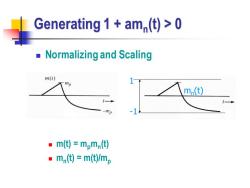
Generating 1 am(t)>0 Normalizing and Scaling m(t) mp m(t) -mp m(t)=mpmn(t) ·mn()=m(mp
Generating 1 + amn (t) > 0 ◼ Normalizing and Scaling ◼ m(t) = mpmn (t) ◼ mn (t) = m(t)/mp mn (t) 1 -1
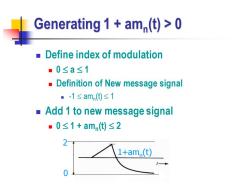
Generating 1+am(t)>0 Define index of modulation ■0≤a≤1 Definition of New message signal m-1≤am()≤1 Add 1 to new message signal ■ ■0≤1+am)≤2 1+am.(t) 0
Generating 1 + amn (t) > 0 ◼ Define index of modulation ◼ 0 a 1 ◼ Definition of New message signal ◼ -1 amn (t) 1 ◼ Add 1 to new message signal ◼ 0 1 + amn (t) 2 1+amn (t) 2 0
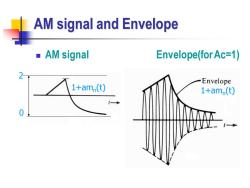
AM signal and Envelope AM signal Envelope(for Ac=1) 2 Envelope 1+am.(t) 1+am (t) 0
AM signal and Envelope ◼ AM signal Envelope(for Ac=1) 1+amn (t) 2 0 1+amn (t)

Wrong choice of a >1 What happens if 1+am(t)<0 Hard to recover m(t)using envelope detector (1+amn(t)) Envelope |1+amp(t)l (1+amn()
Wrong choice of a > 1 ! ◼ What happens if 1 + amn (t) < 0 ◼ Hard to recover m(t) using envelope detector 0 1 |1+amn (t)| -(1+amn (t)) (1+amn (t))
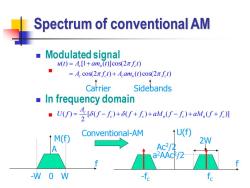
Spectrum of conventional AM Modulated signal u(t)=A.[1+am,(t)]cos(2nft) ■ =A.cos(2πft)+A.amn(t)cos(2πfct) Carier Sidebands In frequency domain ■U)=26U-f)+f+)+aM,f-)+aM.U+】 M(f) Conventional-AM tU(f) 2W A Ac2/2 a2AAc/2 -W 0 W
Spectrum of conventional AM ◼ Modulated signal ◼ ◼ In frequency domain ◼ ( ) [1 ( )]cos(2 ) cos(2 ) ( ) cos(2 ) c n c c c c n c u t A am t f t A f t A am t f t = + = + Carrier Sidebands ( ) [ ( ) ( ) ( ) ( )] 2 c c c n c n c A U f f f f f aM f f aM f f = − + + + − + + -W 0 W f M(f) f U(f) fc -fc 2W Conventional-AM A Ac2 /2 a 2AAc2 /2
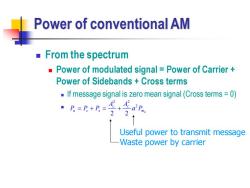
Power of conventional AM From the spectrum Power of modulated signal Power of Carrier Power of Sidebands Cross terms If message signal is zero mean signal (Cross terms =0) ·P=P+P=2+ 2 Useful power to transmit message Waste power by carrier
Power of conventional AM ◼ From the spectrum ◼ Power of modulated signal = Power of Carrier + Power of Sidebands + Cross terms ◼ If message signal is zero mean signal (Cross terms = 0) ◼ 2 2 2 2 2 n c c u c s m A A P P P a P = + = + Useful power to transmit message Waste power by carrier

Modulation efficiency ■Definition ■ 1+d2P% ■n>1asa→o ■Since m,(t)sl,a≤l,we have n≤0.5 "In practice,.n≈0.1 10%of total power is useful power 90%of total power is waste Carrier is filtered out at receiver Efficiency is very low
Modulation efficiency ◼ Definition ◼ ◼ → 1 as a → ◼ Since , we have ◼ In practice, 0.1 ◼ 10% of total power is useful power ◼ 90% of total power is waste ◼ Carrier is filtered out at receiver ◼ Efficiency is very low 2 2 1 n n s m u m P a P P a P = = + m t a n ( ) 1, 1 0.5
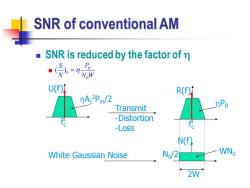
SNR of conventional AM SNR is reduced by the factor of n U(f)1 R(f) nAc2Pm/2 Transmit nPR -Distortion -LOSs N(f) White Gaussian Noise N/2 WNo 2W
SNR of conventional AM ◼ SNR is reduced by the factor of ◼ 0 0 ( ) S PR N N W = fc U(f) Ac 2Pm/2 Transmit -Distortion -Loss fc R(f) PR N(f) 2W N0 White Gaussian Noise /2 WN0
按次数下载不扣除下载券;
注册用户24小时内重复下载只扣除一次;
顺序:VIP每日次数-->可用次数-->下载券;
- 《通信原理实验》课程电子教案(PPT讲稿)MATLAB与通信仿真(英文)Chapter 2 Analog Modulation(AM,Amplitude Modulation).ppt
- 《通信原理实验》课程电子教案(讲稿)MATLAB与通信仿真(英文)Chapter 1 Basic Matlab.doc
- 《通信原理实验》课程电子教案(PPT讲稿)MATLAB与通信仿真电子教案_第1章 matlab基础知识.ppt
- 《通信原理实验》课程电子教案(PPT讲稿)MATLAB与通信仿真电子教案_第3章 图形处理与simulink仿真.ppt
- 《通信原理实验》课程电子教案(PPT讲稿)MATLAB与通信仿真电子教案_第2章 matlab语言入门.ppt
- 《通信原理实验》课程电子教案(PPT讲稿)MATLAB与通信仿真电子教案_matlab在通信中的应用(模拟调制系统).ppt
- 《通信原理实验》课程电子教案(PPT讲稿)MATLAB与通信仿真电子教案_matlab在通信中的应用(模拟信号的数字传输).ppt
- 《通信原理实验》课程电子教案(PPT讲稿)MATLAB与通信仿真电子教案_matlab在通信中的应用(二进制基带系统).ppt
- 《通信原理实验》课程电子教案(PPT讲稿)MATLAB与通信仿真电子教案_matlab在通信中的应用(PSK频带传输系统).doc
- 《通信原理实验》课程电子教案(PPT讲稿)FPGA通信系统设计——第四讲 DDS信号发生器周期信号的傅里叶级数拟合.ppt
- 《通信原理实验》课程电子教案(讲稿)FPGA通信系统设计——第四讲 方波信号展开为傅里叶级数.doc
- 《通信原理实验》课程电子教案(讲稿)FPGA通信系统设计——第四讲 实验四 DDS信号发生器与周期函数的傅里叶级数拟合.doc
- 《通信原理实验》课程电子教案(讲稿)FPGA通信系统设计——第四讲 DDS信号发生器周期信号的傅里叶级数拟合.doc
- 《通信原理实验》课程电子教案(PPT讲稿)FPGA通信系统设计——第二讲 System Generator for DSP.ppt
- 《通信原理实验》课程电子教案(讲稿)FPGA通信系统设计——第二讲 实验二 Nexys 3实验板及设计软件.doc
- 《通信原理实验》课程电子教案(讲稿)FPGA通信系统设计——第三讲 实验三 DA芯片的型号及时序.pdf
- 《通信原理实验》课程电子教案(讲稿)FPGA通信系统设计——第三讲 实验三 DA芯片的型号及时序.doc
- 《通信原理实验》课程电子教案(PPT讲稿)FPGA通信系统设计——第一讲 XilinxFPGA介绍.ppt
- 《通信原理实验》课程电子教案(讲稿)FPGA通信系统设计——第一讲 实验一 FPGA.doc
- 《通信原理实验》课程电子教案(PPT讲稿)FPGA通信系统设计——第一讲 simulink教程(Simulink建模和仿真).ppt
- 《通信原理实验》课程电子教案(PPT讲稿)MATLAB与通信仿真(英文)Chapter 2 Analog Modulation(SSB – AM).ppt
- 《通信原理实验》课程电子教案(讲稿)MATLAB与通信仿真(英文)Chapter 7 Spread Spectrum Communication Systems.doc
- 《通信原理实验》课程电子教案(PPT讲稿)MATLAB与通信仿真(英文)Chapter 2 Analog Modulation(Frequency Modulation、Phase Modulation).ppt
- 《通信原理实验》课程电子教案(PPT讲稿)MATLAB与通信仿真(英文)Chapter 2 Transmitters and Receivers.ppt
- 《通信原理实验》课程电子教案(PPT讲稿)MATLAB与通信仿真(英文)Chapter 3 Analog-to-Digital Conversion(Preview、Measure of Information、Quantization).ppt
- 《通信原理实验》课程电子教案(PPT讲稿)MATLAB与通信仿真(英文)Chapter 3 Analog-to-Digital Conversion(Pulse Amplitude Modulation、Pulse Code Modulation).ppt
- 《通信原理实验》课程电子教案(PPT讲稿)MATLAB与通信仿真(英文)Chapter 4 Baseband Digital Transmission(Binary Signal Transmission).ppt
- 《通信原理实验》课程电子教案(PPT讲稿)MATLAB与通信仿真(英文)Chapter 4 Baseband Digital Transmission(Multiamplitude Signal Transmission).ppt
- 《通信原理实验》课程电子教案(PPT讲稿)MATLAB与通信仿真(英文)Chapter 4 Baseband Digital Transmission(Multidimensional Signals).ppt
- 《通信原理实验》课程电子教案(PPT讲稿)MATLAB与通信仿真(英文)Chapter 5Digital Transmission Through Bandlimited Channels.ppt
- 《通信原理实验》课程电子教案(PPT讲稿)MATLAB与通信仿真(英文)Chapter 6 Binary Modulated Bandpass Signaling(1/3).ppt
- 《通信原理实验》课程电子教案(PPT讲稿)MATLAB与通信仿真(英文)Chapter 6 Binary Modulated Bandpass Signaling(2/3).ppt
- 《通信原理实验》课程电子教案(PPT讲稿)MATLAB与通信仿真(英文)Chapter 6 Binary Modulated Bandpass Signaling(3/3).ppt
- 《通信原理实验》课程电子教案(PPT讲稿)Verilog HDL数字系统设计与综合实验——第01讲 HDL语言概述.ppt
- 《通信原理实验》课程电子教案(PPT讲稿)Verilog HDL数字系统设计与综合实验——第02讲 Verilog HDL语言基础.ppt
- 《通信原理实验》课程电子教案(PPT讲稿)Verilog HDL数字系统设计与综合实验——第03讲 门级与结构建模.ppt
- 《通信原理实验》课程电子教案(PPT讲稿)Verilog HDL数字系统设计与综合实验——第04讲 数据流建模.ppt
- 《通信原理实验》课程电子教案(PPT讲稿)Verilog HDL数字系统设计与综合实验——第05讲 行为建模(1/2).ppt
- 《通信原理实验》课程电子教案(PPT讲稿)Verilog HDL数字系统设计与综合实验——第06讲 行为建模(2/2).ppt
- 《通信原理实验》课程电子教案(PPT讲稿)Verilog HDL数字系统设计与综合实验——第07讲 综合建模与仿真.ppt
